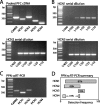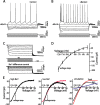Dendritic excitability of mouse frontal cortex pyramidal neurons is shaped by the interaction among HCN, Kir2, and Kleak channels
- PMID: 16177047
- PMCID: PMC6725503
- DOI: 10.1523/JNEUROSCI.2650-05.2005
Dendritic excitability of mouse frontal cortex pyramidal neurons is shaped by the interaction among HCN, Kir2, and Kleak channels
Abstract
Dendritically placed, voltage-sensitive ion channels are key regulators of neuronal synaptic integration. In several cell types, hyperpolarization/cyclic nucleotide gated (HCN) cation channels figure prominently in dendritic mechanisms controlling the temporal summation of excitatory synaptic events. In prefrontal cortex, the sustained activity of pyramidal neurons in working memory tasks is thought to depend on the temporal summation of dendritic excitatory inputs. Yet we know little about how this is accomplished in these neurons and whether HCN channels play a role. To gain a better understanding of this process, layer V-VI pyramidal neurons in slices of mouse prelimbic and infralimbic cortex were studied. Somatic voltage-clamp experiments revealed the presence of rapidly activating and deactivating cationic currents attributable to HCN1/HCN2 channels. These channels were open at the resting membrane potential and had an apparent half-activation voltage near -90 mV. In the same voltage range, K+ currents attributable to Kir2.2/2.3 and K+-selective leak (Kleak) channels were prominent. Computer simulations grounded in the biophysical measurements suggested a dynamic interaction among Kir2, Kleak, and HCN channel currents in shaping membrane potential and the temporal integration of synaptic potentials. This inference was corroborated by experiment. Blockade of Kir2/Kleak channels caused neurons to depolarize, leading to the deactivation of HCN channels, the initiation of regular spiking (4-5 Hz), and enhanced temporal summation of EPSPs. These studies show that HCN channels are key regulators of synaptic integration in prefrontal pyramidal neurons but that their functional contribution is dependent on a partnership with Kir2 and Kleak channels.
Figures









Similar articles
-
Subunit-specific effects of isoflurane on neuronal Ih in HCN1 knockout mice.J Neurophysiol. 2009 Jan;101(1):129-40. doi: 10.1152/jn.01352.2007. Epub 2008 Oct 29. J Neurophysiol. 2009. PMID: 18971302 Free PMC article.
-
Distribution and function of HCN channels in the apical dendritic tuft of neocortical pyramidal neurons.J Neurosci. 2015 Jan 21;35(3):1024-37. doi: 10.1523/JNEUROSCI.2813-14.2015. J Neurosci. 2015. PMID: 25609619 Free PMC article.
-
Selective participation of somatodendritic HCN channels in inhibitory but not excitatory synaptic integration in neurons of the subthalamic nucleus.J Neurosci. 2010 Nov 24;30(47):16025-40. doi: 10.1523/JNEUROSCI.3898-10.2010. J Neurosci. 2010. PMID: 21106841 Free PMC article.
-
HCN channels: function and clinical implications.Neurology. 2013 Jan 15;80(3):304-10. doi: 10.1212/WNL.0b013e31827dec42. Neurology. 2013. PMID: 23319474 Review.
-
Neurophysiology of HCN channels: from cellular functions to multiple regulations.Prog Neurobiol. 2014 Jan;112:1-23. doi: 10.1016/j.pneurobio.2013.10.001. Epub 2013 Oct 29. Prog Neurobiol. 2014. PMID: 24184323 Review.
Cited by
-
Cocaine sensitization increases I h current channel subunit 2 (HCN₂) protein expression in structures of the mesocorticolimbic system.J Mol Neurosci. 2013 May;50(1):234-45. doi: 10.1007/s12031-012-9920-4. Epub 2012 Dec 1. J Mol Neurosci. 2013. PMID: 23203153 Free PMC article.
-
Inward-rectifying potassium (Kir) channels regulate pacemaker activity in spinal nociceptive circuits during early life.J Neurosci. 2013 Feb 20;33(8):3352-62. doi: 10.1523/JNEUROSCI.4365-12.2013. J Neurosci. 2013. PMID: 23426663 Free PMC article.
-
Dopaminergic Modulation of Signal Processing in a Subset of Retinal Bipolar Cells.Front Cell Neurosci. 2020 Aug 14;14:253. doi: 10.3389/fncel.2020.00253. eCollection 2020. Front Cell Neurosci. 2020. PMID: 32922266 Free PMC article.
-
alpha2-Noradrenergic receptors activation enhances excitability and synaptic integration in rat prefrontal cortex pyramidal neurons via inhibition of HCN currents.J Physiol. 2007 Oct 15;584(Pt 2):437-50. doi: 10.1113/jphysiol.2007.141671. Epub 2007 Aug 16. J Physiol. 2007. PMID: 17702809 Free PMC article.
-
Inward rectifier potassium (Kir) current in dopaminergic periglomerular neurons of the mouse olfactory bulb.Front Cell Neurosci. 2014 Aug 8;8:223. doi: 10.3389/fncel.2014.00223. eCollection 2014. Front Cell Neurosci. 2014. PMID: 25152712 Free PMC article.
References
-
- Akins P, Surmeier DJ, Kitai ST (1990) M1 muscarinic acetylcholine receptor in cultured rat neostriatum regulates phosphoinositide hydrolysis. J Neurochem 54: 266–273. - PubMed
-
- Benson DL, Isackson PJ, Gall CM, Jones EG (1992) Contrasting patterns in the localization of glutamic acid decarboxylase and Ca2+/calmodulin protein kinase gene expression in the rat central nervous system. Neuroscience 46: 825–849. - PubMed
-
- Berger T, Larkum ME, Luscher HR (2001) High I(h) channel density in the distal apical dendrite of layer V pyramidal cells increases bidirectional attenuation of EPSPs. J Neurophysiol 85: 855–868. - PubMed
Publication types
MeSH terms
Substances
Grants and funding
LinkOut - more resources
Full Text Sources
Other Literature Sources
Molecular Biology Databases
